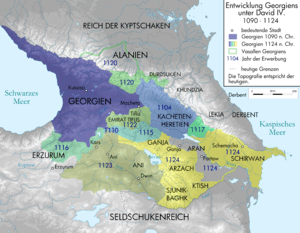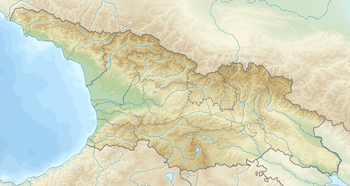Siege of Tbilisi (1122)
| Siege of Tbilisi | |||||||
|---|---|---|---|---|---|---|---|
| Part of Georgian–Seljuk wars | |||||||
 Expansion of Kingdom of Georgia under David IV's reign. | |||||||
| |||||||
| Belligerents | |||||||
|
| |||||||
| Commanders and leaders | |||||||
| David IV | |||||||
 Tbilisi Location of Tbilisi in Georgia with present-day administrative borders. | |||||||
The Siege of Tbilisi was the successful siege of the city of Tbilisi, capital of the Emirate of Tbilisi, by the Georgians under King David IV, which ended in 1122. As a result, the Georgians were able to liberate the entire region from Muslim influence and even contest territories within the Seljuq Empire, which at that point was left almost defenceless.
History
The Kingdom of Georgia had been a tributary to the Seljuq Empire since the 1080s. In this dark time, known as the Great Turkish Onslaught, young King David IV was able to exploit internal unrest in the Seljuq state and the success of the Western European First Crusade against Muslim control of the Holy Land, and established a relatively strong monarchy, reorganizing his army and recruiting Kipchak, Alan, and even Frankish mercenaries to lead them to the reconquest of lost lands and the expulsion of Turkish raiders. David's battles were not, like those of the Crusaders, part of a religious war against Islam, but rather were a political-military effort to liberate Georgia from the nomadic Seljuks.
Starting in 1120, King David began a more aggressive policy of expansion. In the winter of 1120–1121 the Georgian troops successfully attacked the Seljuk settlements on the eastern and southwestern approaches to the Transcaucasus. Muslim powers became increasingly concerned about the rapid rise of a Christian state in southern Caucasia. In 1121, Sultan Mahmud b. Muhammad (c. 1118–1131) declared a holy war on Georgia. However, 12 August 1121, King David routed the enemy army on the fields of Didgori, with fleeing Seljuq Turks being run down by pursuing Georgian cavalry for several days.
The unification of Georgia and the elimination of Muslim authority was completed in the year following the battle at Didgori. In June 1121 David IV began laying siege to Tbilisi, an ancient Georgian city and last Muslim enclave remaining from the Muslim occupation. In 1122 he captured the city of Tbilisi, which for nearly four hundred years had been an Islamic town. David moved his residence from Kutaisi (western Georgia) to Tbilisi, making it the capital of a unified Georgian State and thus inaugurating the Georgian Golden Age.
Five hundred citizens were tortured to death, and much of the city burned. Tbilisi became a royal town, the capital of Georgia, "for ever an arsenal and capital for his sons." The medieval sources emphasize David’s acts of revenge against the Muslims of Tbilisi. However, the Arab historian al-'Ayni (1360–1451), who utilizes sources, some of which have not survived, admits that the city was pillaged but says that the Georgian king eventually showed patience and "respected the feelings of the Muslims."[1][2] A well-educated man, he preached tolerance and acceptance of other religions, abrogated taxes and services for the Muslims and Jews, and protected the Sufis and Muslim scholars.
References
- ↑ Minorsky, Vladimir (1993). "Tiflis". In Houtsma, M. Th.; van Donzel, E. E. J. Brill's First Encyclopaedia of Islam, 1913–1936. Brill. p. 755. ISBN 90-04-08265-4.
- ↑ (in Georgian) Javakhishvili, Ivane (1982), k'art'veli eris istoria (The History of the Georgian Nation), vol. 2, pp. 184-187. Tbilisi State University Press.
